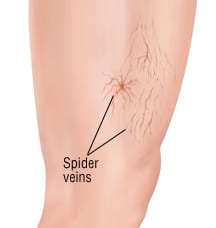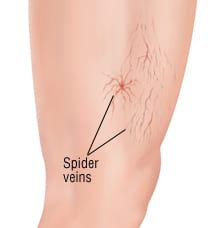Patient Basics: Spider Veins
Originally published by Harvard Health.
What Is It?
Superficial leg veins, sometimes called “spider veins” occur when tiny veins congregate below the surface of the skin, causing red, blue or purple discolorations. Spider veins get their name from the shape of the discolorations. Some cases of spider veins can be quite small. Others are more noticeable. They may make you feel self-conscious, but they are harmless, and any treatment is usually done for cosmetic reasons only.
Spider veins are most common on the thighs, ankles and calves, and are more common in women than men. Their cause isn’t completely understood in every case, but they can run in families. Some cases are related to pregnancy, use of birth control pills or weight gain.
Other types of problematic veins that can appear similar to spider veins include:
- Telangiectasias, which are dilated capillaries close to the skin, and tend to be more noticeable on the face, whereas spider veins more commonly occur on the legs and feet
- Hemangiomas and angiomas, which are made up of very small arteries called arterioles or very small veins called venules.
Sometimes, the terms spider veins and telangiectasias are used interchangeably.
Symptoms
Red or bluish-purple blood vessels appear, usually on the legs or thighs, but sometimes on the face, forearms or hands. Spider veins usually do not cause any symptoms, but rarely may cause a mild dull discomfort or burning sensation.
Diagnosis
Your health care professional can diagnose spider veins by looking at them.
Expected Duration
Spider veins may be permanent or may disappear on their own after a period of months, especially if they are caused by pregnancy or certain medications.
Prevention
Because the causes of spider veins aren’t completely understood, they can’t always be prevented. It’s helpful to maintain a healthy weight and stay physically fit.
If you have spider veins, you might help to avoid developing more of them by not standing still or crossing your legs for prolonged periods of time and by wearing support stockings.
Treatment
Spider veins do not require treatment. In some people, support stockings may decrease the size of existing spider veins and help to prevent new ones. The two most common cosmetic treatments for spider veins are sclerotherapy and laser treatment:
- Sclerotherapy involves having a salt solution injected directly into the affected area, causing the veins to collapse. The area may be tender for a few days and it may bruise, but bruising should fade over a few weeks. Sclerotherapy may require multiple treatments. The injections can be slightly painful.
- Laser treatment directs pulses from a laser light to the spider veins, causing tiny blood clots to form. The blood vessels become blocked off and eventually are reabsorbed by the body.
When To Call a Professional
Spider veins are not harmful to your overall health. If you are self-conscious about your spider veins, or if they become painful or tender, see your doctor about the possibility of treatment.
Prognosis
If you decide on cosmetic treatment for your spider veins, you can expect a 50% to 90% improvement. You may need several treatment sessions to achieve the desired result. After treatment, a slight discoloration of the skin may remain for weeks or even as long as a year before fading. In many cases, spider veins disappear entirely, but they can return.
Additional Info
American Academy of Dermatology
P.O. Box 4014
Schaumburg, IL 60168-4014
Phone: 847-330-0230
Toll-Free: 1-888-462-3376
Fax: 847-330-0050
http://www.aad.org/


